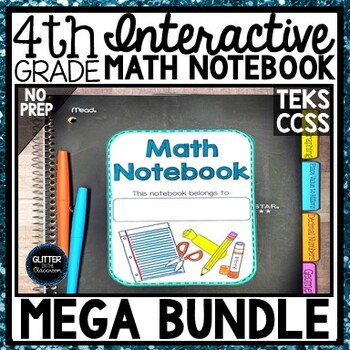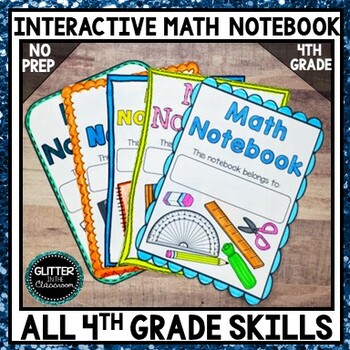4th Grade Interactive Math Notebook MEGA Bundle - 4th Grade Math TEKS - CCSS
- Zip
What educators are saying
Products in this Bundle (16)
showing 1-5 of 16 products
Description
Your students will love these interactive math notebook resources that address all 4th grade math content. These NO PREP resources make introducing new math content easier and less stressful for you and your students. These are meant to be scaffolded notes that guide students through all 4th grade math concepts and skills. These resources address the TEKS and CCSS. These notebook resources will allow your students to build a deep and meaningful understanding of their 4th grade math content while they create a colorful math notebook they can refer to all year long. Check out the preview to see more!
Many of these notebook resources are accompanied by helpful math videos! Watch for the QR codes included in the notes!
Math Notebook Resources Included In This Bundle:
- Data & Graphing
- Place Value-Whole Numbers To Billions
- Decimal Place Value-Tenths & Hundredths
- Compatible Numbers
- Addition & Subtraction-Whole Numbers and Decimals to the Hundredths
- Strip Diagrams – (Tape Diagrams, Bar Models)
- Input-Output Tables
- Multiplication and Division
- Geometry
- Fractions
- Area & Perimeter-Measurement
- Elapsed Time-Measurement
- Measurement-Capacity, Length, & Weight
- Division With Remainders-An Introduction
- Division With Remainders-Interpreting the Remainder
- Personal Financial Literacy
Additional Product Features (Included in each Interactive Math Notebook):
- About This Product Page
- How To Use 1/2 Page Notes - copied front to back and folded like a book
- Table of Contents Pages - includes different sizes for teacher convenience
- Teacher Grading Rubric - includes different sizes for teacher convenience
- 5 Different Notebook Covers - so that your students have choices
- Student Notebook Contract
- Divider Tabs for each notebook section
- "Neat & Complete" Awards - for a job well done on your student's notebook
- Answer Keys - for each page of notes (includes teacher notes and examples)
Related Products
⭐ 4th Grade Math Homework - Entire Year - 36 Weeks
⭐ 4th Grade Math Warm Up and Spiral Review - ENTIRE YEAR - Daily Math Practice
More About This Product:
Interactive notebooks are a great way to introduce new math concepts, vocabulary, & key ideas to your students, while they record their learning in a concrete place. These notes lend themselves very well to the, "I Do, We Do, You Do" model of teaching. You can use these notes when you are teaching in whole group or small group. You can teach directly from the notes or use the notes as a follow up to your initial instruction.
Other Ways To Use This Product:
- during guided math
- independent work
- to reteach skills
- extra practice to address specific skills
- RTI resource
This product gets updated often to make it the most relevant and beneficial to the every day math classroom. When you purchase this resource you'll receive all updates for free!
If you purchase this product and find an error PLEASE message me through TPT! I'll greatly appreciate it, and I'll correct it right away.
THANK YOU for stopping by!
©Fabie Lozano
All rights reserved by author.
Permission to copy for single classroom use only.
Electronic distribution limited to single classroom use only.





